#Hymenoptera
Text

My new earrings!!! 😃 (Everybody, act surprised)..... 🤯
For those interested, you can get them on Etsy!
#hymenoptera#insect#entomology#wasp#wasps#apocrita#aculeata#vespidae#vespoidea#vespinae#Vespula#Vespulagermanica#earrings#yellowjackets#waspearrings#yellowjacketearrings
134 notes
·
View notes
Text
Bug of the Day
My veggie prison brings all the wasps to the yard.
And they're like, I'm gonna just chew up a bit of this wood here and turn it into a nest...
#bug of the day#BotD#insect#wasp#hymenoptera#Polistes fuscatus#Northern paper wasp#Polistes#Vespidae
64 notes
·
View notes
Text




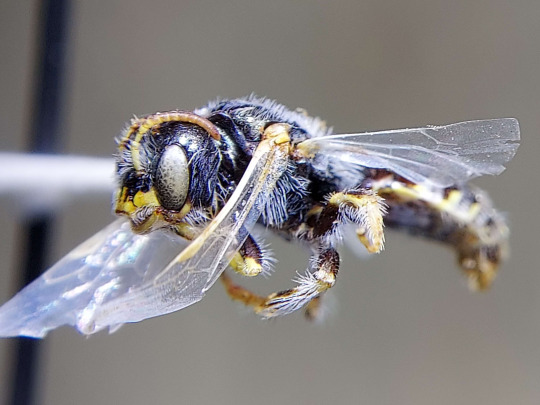

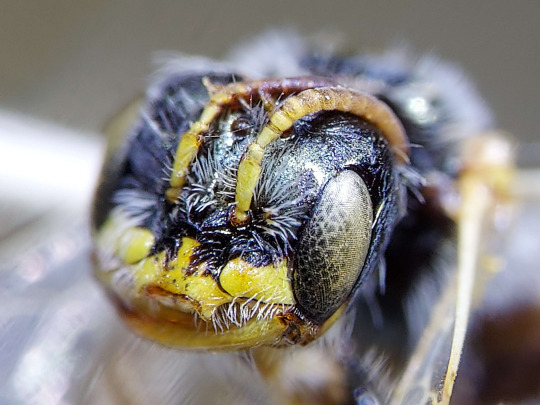
i started looking at some unidentified fairy bees (Perdita spp.) in my lab's collection today. this is the most diverse genus of bees in north america with over 550 described species in just the US. they're extremely tiny and extremely weird and extremely hard to ID.
the first one is probably a male of the monotypic subgenus Xeromacrotera and one of the few members of the genus to be awarded a common name, the Big-Headed Fairy Bee, Perdita cephalotes, which actually display a whole range of head sizes as you can see in this figure.
EDIT: nope i'm a dummy. the first one is actually something in the extremely tricky ventralis group in the Perdita sensu stricto subgenus.
bottom two are a female and male in the subgenus Cockerellia (named after Theodore "Mr Too Damn Many Bees" Cockerell), probably both at least closely related to the species Perdita albipennis.
63 notes
·
View notes
Text

Today's anime insect of the day is: a bee from A Sign of Affection
Order: Hymenoptera
Family: Apidae
35 notes
·
View notes
Text
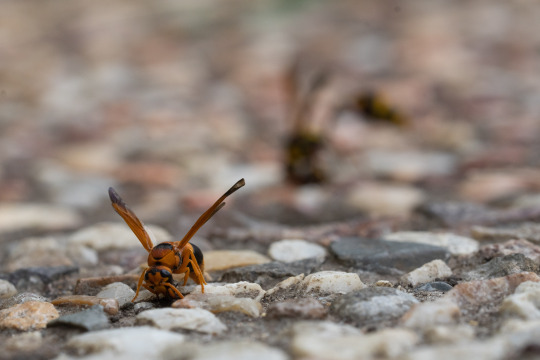
had the pleasure of watching two Potter wasp ladies collecting dirt side-by-side. both are members of the subfamily Eumeninae, a cosmopolitan group of wasps containing over 3000 species across 198 recognised genera (over 300 species found here in Australia).
the photo below is a familiar face for the blog, the same species of Potter wasp that I photographed drinking from the pond last Summer, some of my favourite photos I've taken so far.
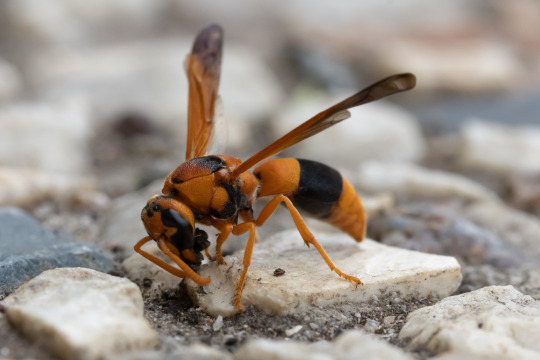
her dirt-collecting companion has also appeared on the blog before, and is the Yellow-and-black Potter Wasp (Delta campaniforme). this individual was seen taking her dirt-ball right into the arm of one of our lawn chairs to build her nursery :')
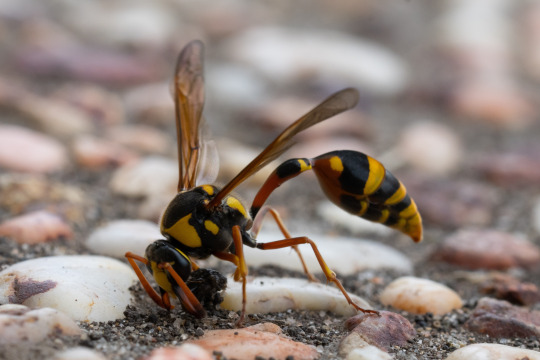
(middle) Unknown Potter Wasp, female (subfamily Eumeninae), April '24.
(bottom) Yellow-and-black Potter Wasp, female (Delta campaniforme), April '24.
#ive also had to edit the original pond drinker post#it seems i was too hasty to put a confident ID on her#she remains unknown for now!#ljsbugblog#bugblr#entomology#macro#unconfirmed id#insects#hymenoptera#aculeata#vespidae#wasps#eumeninae#potter wasps#delta#delta campaniforme#yellow-and-black potter wasp
29 notes
·
View notes
Text
Leafcutter Bees: these bees snip off bits of foliage and/or flower petals and then weave the pieces together to build their nests
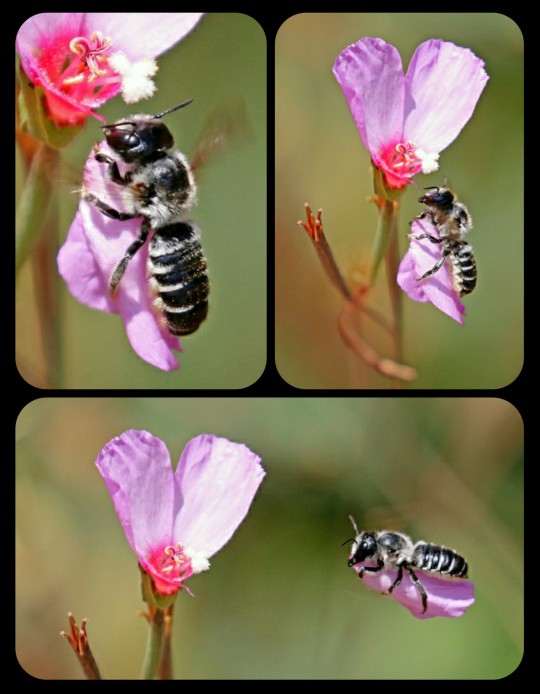
The nests are built and used only by the female leafcutter bees (family Megachilidae). Unlike honey bees, leafcutters do not form colonies or live together in hives, meaning that each nest belongs to a single, solitary bee.

The females use their mandibles to cut out pieces of foliage, carefully snipping off rounded segments and then carrying them back to an existing cavity/burrow (which may be located in a plant stem, a piece of wood, the side of a tree, etc.), where the pieces are used to construct a series of brood cells along the inner walls of the cavity.
Most leafcutter bees build their nests out of leaves, but there are some species that are more accurately described as "petalcutters," because they use flower petals instead.
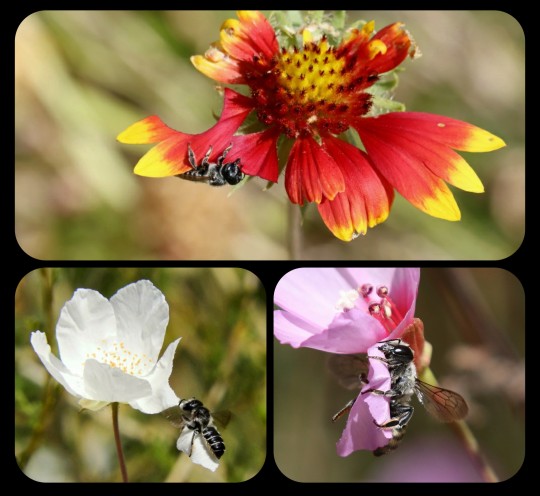
The Silver-Tailed Petalcutter Bee (M. montivaga): this species uses flower petals to build its nest; it is one of the few Megachilid bees to do so
The leaves and/or flower petals are then folded together along the inner walls of the chamber, forming a long, cigar-shaped nest that contains multiple brood cells.

As this article explains:
Leafcutter bees may nest in many different spaces, such as existing holes in timber or masonry, hollow stems, gaps in door/window frames, old folded towels left outside, rock walls and outdoor furniture.
Each female builds her own nest. The cut leaves are used to make a tube as a nest for the eggs or to line an existing hole with it. The leaves are cut in various shapes, round and elongated, to suit the construction of the cell for the eggs. The cell is then stocked with a mixture of nectar and pollen in which the leafcutter bee lays her eggs.
There are multiple brood cells built into the internal structure of the nest, but they are all separate from one another. Each cell contains a single egg, along with just enough pollen and nectar to sustain the larva until it reaches maturity.
When the eggs hatch, tiny larvae eat the provisions and, when fully grown, they spin silky cocoons and then develop into pupae, finally emerging as adult bees.
Leafcutter bees come in a wide variety of colors, shapes, and sizes. These are just a few other examples:
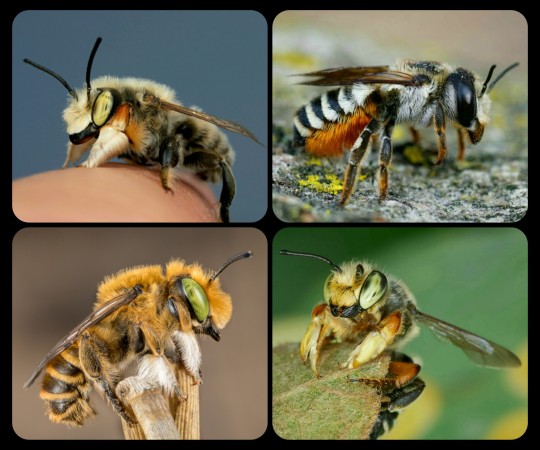
Top Row (left-to-right): Megachile latimanus and Megachile octosignata; Bottom Row: Megachiloides sp. and Megachile poeyi
Sources & More Info:
University of Colorado's Museum of Natural History: Leafcutting Bee
Florida Wildflower Foundation: Getting to Know your Native Pollinators - Leafcutter Bees
University of Nebraska: Facts about the Leafcutter Bee
Land for Wildlife (Southeast Queensland): Leafcutter Bees
What's that Bug?: Leafcutter Bee Life Cycle - a Fascinating Journey Revealed
Entomology Today: Beyond the Honey Bee - How Pesticides Affect Solitary, Cavity-Nesting Bees
#entomology#insects#nature#hymenoptera#arthropods#megachile#megachilidae#leafcutter bees#petalcutter bees#animals#biology#flowers#cute bugs#bees#solitary bees#gardening#plants#cute animals#bugs that like to pick flowers#to decorate their homes
21 notes
·
View notes
Text
fuzzy puffs love artichoke fluffs pt 2
#bugs#bugblr#insects#insect#bug#entomology#found elsewhere and uploaded by me#tiktok#bee#bees#bumblebees#hymenoptera
18K notes
·
View notes
Text
Wasps so tiny you will question everything.
Imagine being so teeny tiny that you are an endoparasite on *leafhoppers* Leafhoppers are already in the "so small they go unnoticed" category, and you're just a little pest on a minuscule thing.
Of course the group that's most likely to choose this life? The wasps Wasps are some of the smallest insects. There are "fairy flies" that are parasites of the eggs of certain insects.
They are so small that air is "thick" to them and their wings have feathered edges are are oar shaped.
Some fairly flies are so tiny that their neurons are cells without nuclei. They got rid of them to save space. They can still think though... presumably the tiniest little thoughts.
Photo by Alexey Polilov, 2012
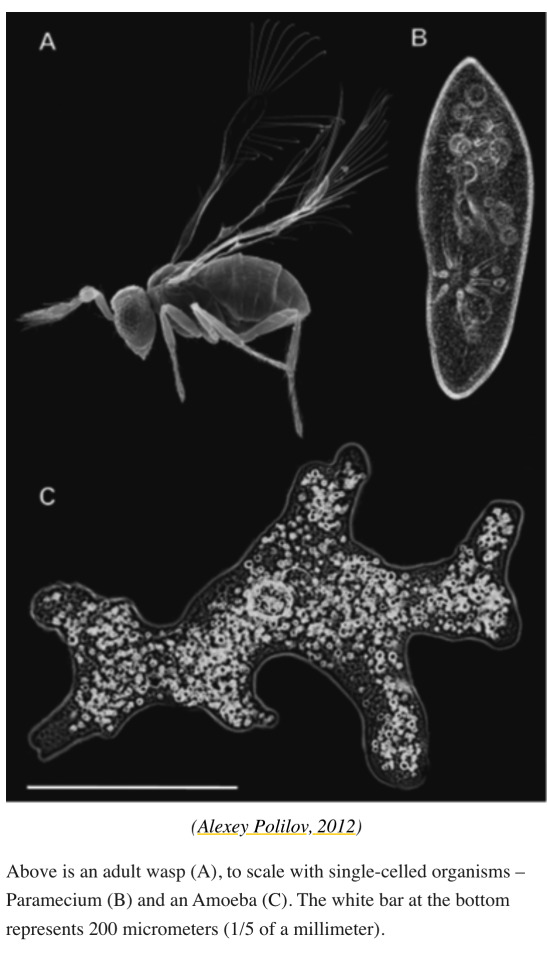
They lay their eggs inside of the eggs of 1-2mm long crop pests.
And... read the article to see what the males are like... they are even smaller somehow, but it's ... disturbing.
#tiny#too tiny#so smol#smol#hymenoptera#wasp#wasps#fairycore#fairy flies#Megaphragma mymaripenne#Megaphragma#little#bug#bugblr#cute bugs#arthropods#insects#invertebrates
6K notes
·
View notes
Text
Random bee behavior fact for those who wish to read, just because I feel like it and because it’s late and I’m stalling on sleeping:
Bumblebees may seem like passive, cuddly, and docile creatures, but they won’t hesitate to defend themselves if they feel as if their warnings aren’t being read or taken seriously.
I.e. the photo and diagram below, when a bee feels threatened they will raise one or more of their legs into the air, signaling to whatever or whomever may be bothering them as a message essentiality saying: “hey, back off, too close!”


species pictured: bombus pascuorum, bombus impatiens
If their defensive posture goes unnoticed or ignored, they may be pushed into defending themselves by stinging (which is also a stressful experience for not only one such as yourself, but also for the bee.) If you ever find yourself getting close to a bumblebee while taking pictures, walking close to them, or just admiring them, remember this posture! If a bee does this, it is simply asking you to take a step back as it feels it is being threatened.
Now you can understand and use this knowledge to your advantage if you ever come across one in the future. (Of course, because it’s very hard not to anthropomorphize animals, I do have to admit that they do look pretty cute when doing it. Just remember to respect them though!)
24K notes
·
View notes
Text


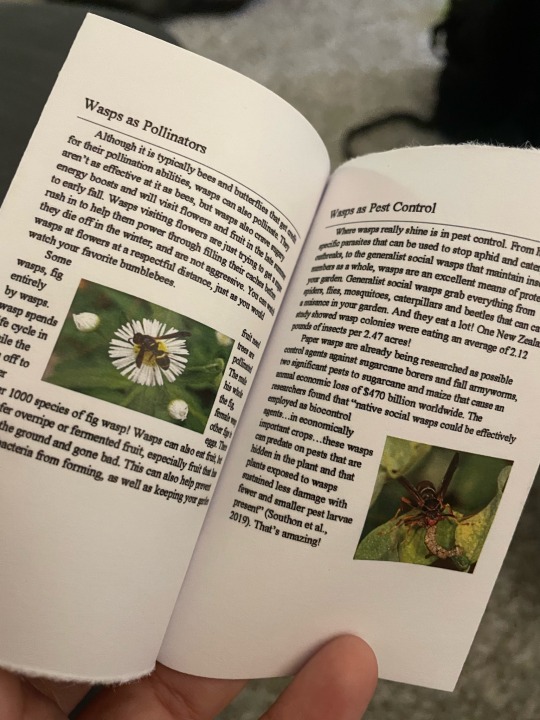
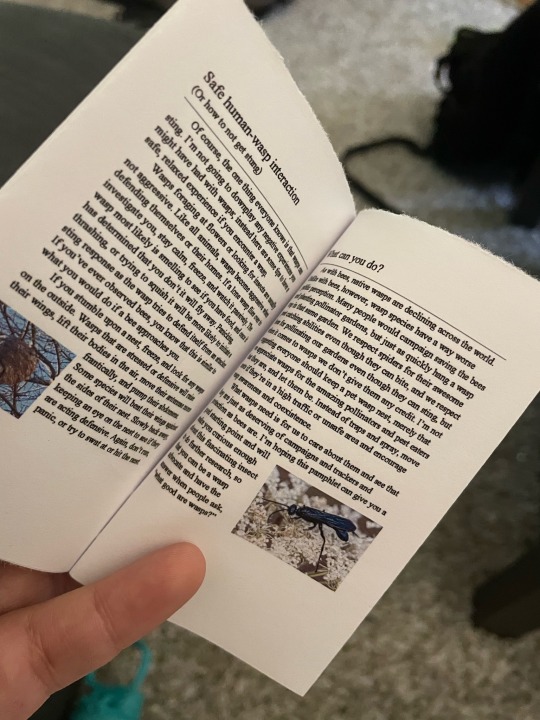
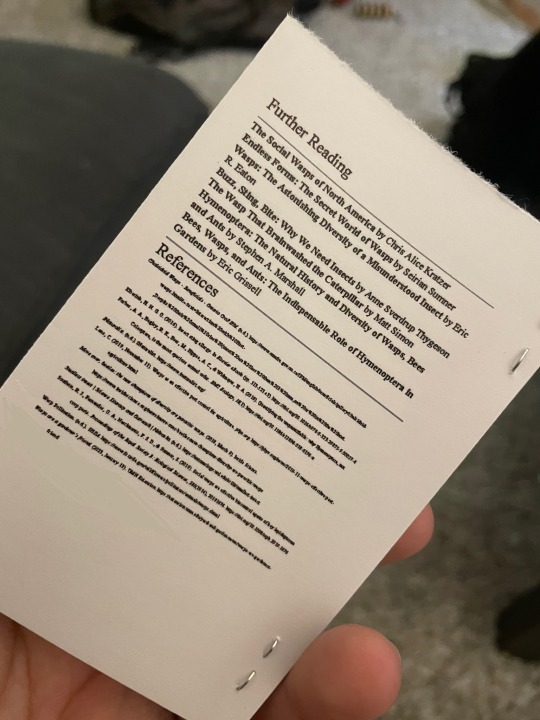
Finally got the full color version of my wasp zine printed!
Here's the full docx file if you want to read it!
5K notes
·
View notes
Text

ants were farming other animals long before humans figured it out! here is a Cautolasius herdswoman with her livestock


many subterranean Lasius species cultivate flocks of plump root aphids, guarding them against predators and moving them to safe locations and fresh pastures. they “milk” the aphids for honeydew, a sugary waste product of the aphids’ digestion. I’ve read the ants will only kill and eat their livestock in times of famine.

when I flipped their rock, this ant grabbed the nearest aphid and ran it to safety. she’s another species of Lasius, this one in the subgenus Chthonolasius; I can’t tell if her colony’s aphids are different from the Cautolasius’ though.
2K notes
·
View notes
Text
Okay, so this is really cool! You have this phenomenon where some plants grow edible appendages to their seeds to entice ants to carry them underground where they can safely sprout. And then you have wasps which lay their eggs on the leaves, stems, and other parts of plants and trigger the growth of galls (swellings) which both feed and protect the wasp larvae until they reach maturity.
The boy who was watching the ants noticed they were taking wasp galls underground, too. Further exploration found that the wasp larvae were unharmed inside the galls; the only thing the ants had eaten were edible appendages similar to those on the seeds they collected. The wasp larvae stayed safe inside the ant nest, feeding on their galls, until it was time to emerge and head back out to the surface.
So it turns out that the edible portions of the galls have the same sorts of fatty acids as the edible parts of the seeds. And those fatty acids are also found in dead insects. Scientists think that the wasps evolved a way to make the galls they created mimic the edible portions of the seeds to get the ants to collect the galls. This isn't the only example of wasps making use of ants as caretakers for their young, but it's a really fascinating example thereof--especially if you consider ants evolved from wasps at least 100 million years ago.
#wasps#ants#plants#galls#oak galls#insects#invertebrates#Hymenoptera#ecology#bugs#animals#wildlife#nature#trees#entomology#science#natural science#evolution#animal behavior
13K notes
·
View notes
Text

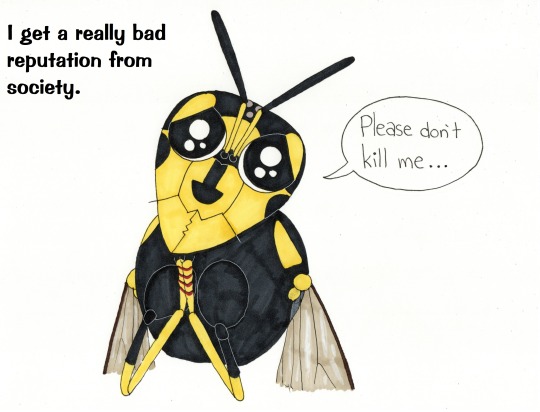


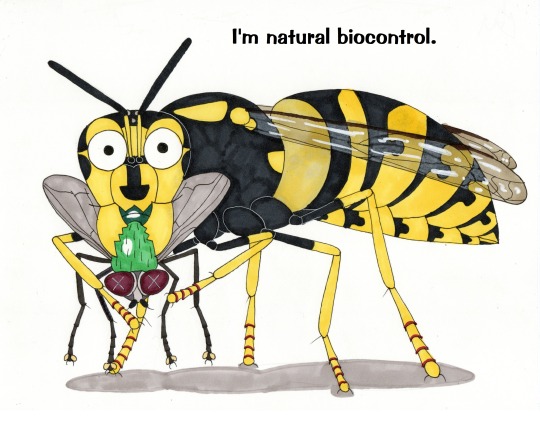

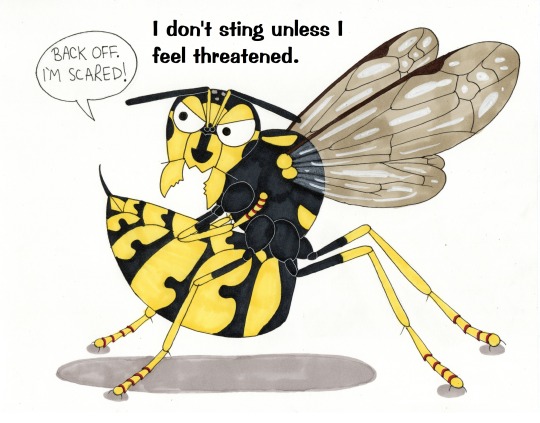
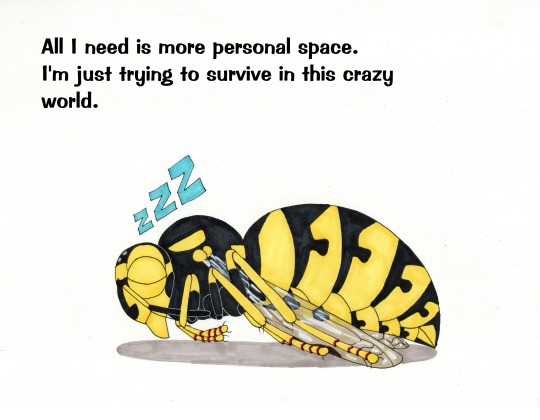
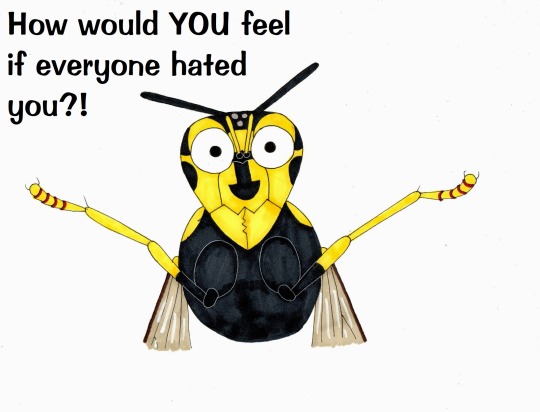
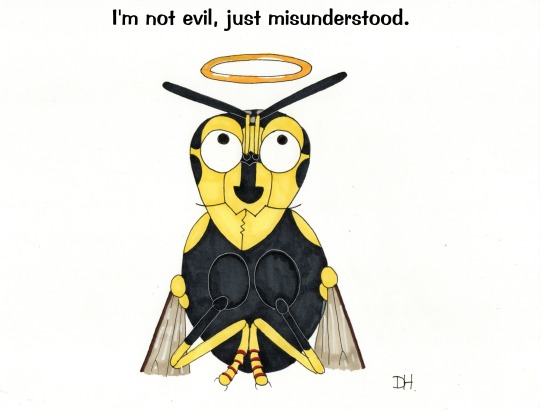
Yellowjackets - a short story.
I root for them because I think they're awesome. This took a lot of time and effort (I draw everything by hand), so if you hate wasps, that's fine, but just move on. I don't have the energy to deal with irrational hate.
I'm aware that some people are allergic and afraid, and that's totally valid. You don't have to love wasps, but try to understand their place in nature.
#wasps#wasp#entomology#insect#hymenoptera#apocrita#aculeata#cartoon#vespidae#vespoidea#comic#Vespula#Vespinae#Vespulaalascensis#AShortStory#YellowJackets
1K notes
·
View notes
Text

excellent chompers on this little fella. male mining bee, Andrena sp., tentatively IDed as A. frigida.
1K notes
·
View notes
Text
this mud dauber wasp (Sceliphron caementarium) seemed distressed about something in her clay nest. Turns out it had been commandeered by a keyhole wasp (Pachodynerus nasidens), who was now aggressively asserting ownership
keyhole wasps, which hunt weevils and other small beetles, will opportunistically nest in any sort of small cavity (such as a keyhole). The existing literature on this species doesn’t say anything about taking over other wasp‘s nests, only that they sometimes refurbish abandoned nests, but I guess this one didn’t get the memo.
This isn't the worst of their mischief though- they also have a habit of building nests that clog up the airspeed measuring instruments in planes and have caused several fatal crashes.
(Florida, 10/6/21)
#hymenoptera#wasps#mud dauber#keyhole wasp#eumeninae#vespidae#sceliphron caementarium#pachodynerus nasidens#bugs#bugblr#insects#biology#entomology
14K notes
·
View notes
Text
this Mud-dauber Wasp chose our windowsil to build her nest! after a bit of investigation of me and my camera, she graciously allowed me to photograph her while she worked on her construction.
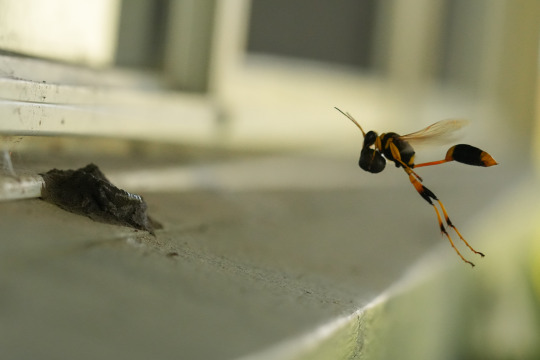

in the photos above, she has arrived with a ball of mud collected from somewhere nearby. this nest isn't for her to live in, but for her young to grow and pupate. in this mass of mud she will craft several individual cells, and provision them all with the paralysed bodies of orb-weaver spiders. each cell will have a single egg laid on the first spider, before being sealed off with more mud.
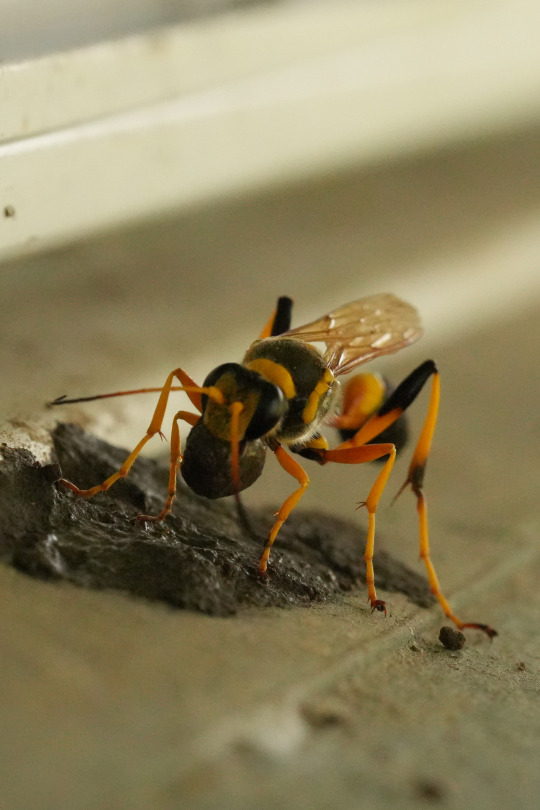
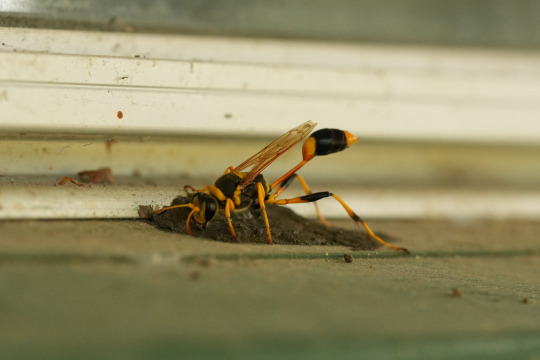
here, she picks the next spot to deposit her ball of mud, using her mandibles to smooth it onto the structure. when the larvae hatch, they will consume all the spiders in their respective cells, before pupating and then emerging as adults wasps.

each time she finished with a layer of mud, she would take a moment to groom her forelegs and antennae, before flying off to repeat the process. these photos were taken earlier in the Summer, and as of posting this, the adult wasps have yet to emerge.
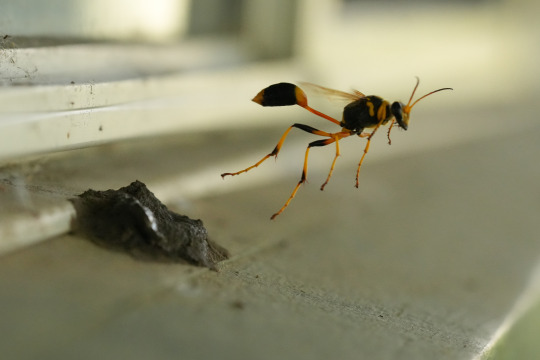
Covered-cell Mud-dauber Wasp, female (Sceliphron laetum).
#ljsbugblog#bugblr#entomology#macro#insects#hymenoptera#aculeata#wasps#sphecidae#thread-waisted wasps#sceliphron#slender mud-dauber wasps#sceliphron laetum#covered-cell mud-dauber wasp
1K notes
·
View notes